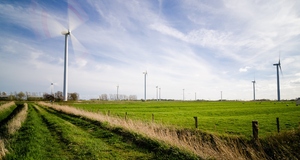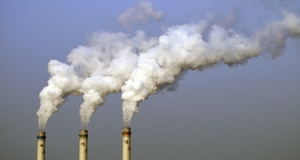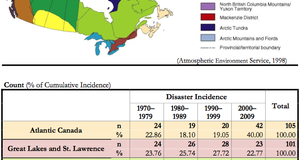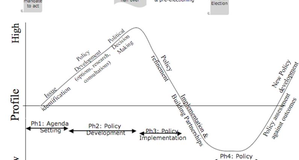|
The Inequalities of Climate Change and Poverty: Impact Analysis and Potential Solutions
One mechanism that will be extremely important in combatting climate change and offsetting future greenhouse gas emissions is renewable energy. Energy is also an essential component of economic development and poverty alleviation, as highlighted in the United Nations Millennium Development Goals. In order to effectively balance these goals of ending energy poverty and promoting sustainable development, renewable energy must be employed (34).
For the past few decades in developing countries, the energy needs of poor people have been largely met through petroleum-based liquid fuels and extensions of the electricity grid, fueled primarily by fossil fuels and hydropower, primarily due to government subsidies and the widespread global availability of these resources. While this has sufficed in more developed areas, it still leaves out people in remote areas, or even urban slums, due to high costs or lack of access. It is also important to note that most of the fossil fuels and technologies used by these developing countries are imported. Of the 47 poorest countries in 2004, 38 were net importers of oil and 25 imported all of their oil (34).
The argument for renewable energy is supported in practice. In rural areas, traditional electricity grid extensions are simply not practical or economical. Studies by the International Energy Agency have shown that renewable energy technologies in developing countries, while reducing carbon dioxide emissions at the same rate as in developed countries, actually have a lower associated cost due to their cost-competitiveness in decentralized energy areas. These technologies can also extend reliable energy access to the approximately 1.5 billion people in rural, developing areas without traditional grid access (35).
Projects in many developing countries have shown that renewables can directly contribute to poverty alleviation by providing necessary energy for businesses and jobs. Furthermore, renewable technologies can make indirect contributions to alleviate poverty and increase the standard of living by providing energy for activities such as cooking, heating, and lighting. This in turn contributes to increased education, decreased health risks, and other positive benefits in local communities (34).
The positive ramifications of employing renewable energy technologies in developing countries can be seen in Bangladesh, which was previously highlighted as the most susceptible country in the world to climate change and a leader in climate change adaptation and mitigation practices. In 2007, an estimated 40 percent of the country’s population had no access to electricity. With support from the World Bank, the government introduced the solar home systems (SHS) project to provide electricity to households with no grid access. Since 2009, more than 50,000 systems have been added per month, reaching 3 million households in 2014, with projections of 6 million households by 2017. Thanks to the SHS program, the Bangladeshi government is working towards universal electricity access by 2017, just a decade since the project was first proposed (36).
In order for renewable energy to be effectively employed, especially in developing countries, it is first necessary to switch subsidies from fossil fuels to renewable technologies. In particular, in order to maximize the benefits for local communities, programs should focus on small, off-grid projects in rural, underdeveloped areas. Furthermore, as previously emphasized for all adaptation and mitigation practices, it is necessary for an exchange of not only financial capital, but also technology information sharing in order to accelerate the spread of renewable energy technologies, particularly in developing countries where this knowledge may be limited or nonexistent. Therefore, significant time and financial investments need to be made specifically for this technology development, transfer, and education (35).
The impacts of climate change are often difficult to assess, in part due to the problem’s long-term (intergenerational) impacts as well as political obstacles and an unequal distribution of cost as previously addressed. Therefore, while many strategies have been proposed (and some adopted), it remains a challenging issue. One practice highlighted by the UNFCCC to deal with the challenging nature of the climate change problem is sequential decision making. This strategy recognizes that any decisions made regarding climate change will be done with incomplete data, particularly regarding long-term impacts. Therefore, additional strategies must take into account risk management techniques and sustainable development. However, it is important to recognize at the same time that if economic resources are devoted to these initiatives, other areas of economic development could potentially suffer as a result (37).
In addition to practices previously mentioned such as the Green Climate Fund, renewable energy technologies, and the exchange of skills and ideas, there are several other propositions to combat climate change while simultaneously alleviating poverty worldwide.
A popular tax proposal is the carbon tax as a potentially cost-effective means of reducing emissions. Historically, while this has been implemented in a number of countries around the world, it has been resisted by many of the world’s largest emitters, including the United States, Russia, and China. The carbon tax is an indirect tax that effectively sets the price for carbon dioxide emissions. In addition to creating incentives for energy conservation, a carbon tax also allows renewable energy sources such as solar or geothermal to be more competitive, stimulating investment and growth in those markets (38).
Alternatively, a unique, largely untested, proposal, first reported in the IPCC’s 2nd Assessment Report, is insurance policies that create financial markets for risk can be used to respond to climate change. One way to do this is through binding agreements between countries. Through mutual insurance contracts, countries suffering from above average climate-related losses would be assisted by other countries only suffering from below average losses. However, given the difficulties seen in creating binding agreements within the Paris Agreement, it is unlikely that a plan such as this would ever come to fruition (37).
Alternatively, another insurance policy technique would be to trade “risk securities” among countries, a practice akin to betting on particular climate outcomes. This would ideally lead to a more fair distribution of climate change risks and could provide a check of honesty to see what a country really believes about climate change. For instance, countries believing that climate change presents a low risk would be more prone to hold securities against those risks (37).
In summary, climate change is a global problem largely due to the actions of developed nations. However, it is the poorest people in poorer, developing nations that are expected to suffer the most from its negative impacts. This can be seen most prominently in Asia, where many of the countries most susceptible to climate change are located, including Bangladesh and the Philippines. At the same time in Asia, countries such as China and India have seen rampant growth in the past decade using both renewable and non-renewable energy sources. As a result, these emerging world powers, as well as smaller countries in Asia, have taken on greater leadership roles and made their voices heard at international meetings such as the annual UNFCCC COPs.
While this has led to some progress, particularly in funding for climate related adaptation and mitigation practices, there remains a significant amount to be done. Future work must take into account the inequalities among those who cause and are impacted by climate change when considering global policy solutions. Furthermore, there must be an exchange not only of financial capital, but also ideas, leadership, and new technologies in order to simultaneously address issues of both climate change and poverty worldwide.
I would like to thank Dr. Mary Kopecki-Fjetland for her constant support and guidance throughout this project. Thanks also to the American Chemical Society Students on Climate Change program, led by Drs. Keith Peterman and Greg Foy, which helped inspire this project and allowed for my research at COP21 in Paris, France. Funding was provided by St. Edward’s University’s School of Natural Sciences, American Chemical Society Student Affiliate Chapter, Fellowships Office, Sustainability Office, and Academic Affairs.
- Saad, Lydia, and Jeffrey M. Jones. "U.S. Concern About Global Warming at Eight-Year High." Gallup, 16 Mar. 2016. Web. 5 May 2016.
- "Climate Change Facts: Answers to Common Questions." Climate Change Facts: Answers to Common Questions. United States Environmental Protection Agency, n.d. Web. 27 Apr. 2016.
- Shabecoff, Philip. "Global Warming Has Begun, Expert Tells Senate." The New York Times. The New York Times, 23 June 1988. Web. 27 Apr. 2016.
- Oreskes, Naomi. "The Scientific Consensus on Climate Change." Science Translational Medicine 1686th ser. 306.5702 (2005): n. pag. American Association for the Advancement of Science, 2 Dec. 2004. Web. 27 Apr. 2016.
- Lavelle, Marianne. "Survey Tracks Scientists' Growing Climate Concern." U.S. News, 23 Apr. 2008. Web. 27 Apr. 2016.
- Bray, Dennis; von Storch, Hans (2009). "A Survey of the Perspectives of Climate Scientists Concerning Climate Science and Climate Change" (PDF).
- Doran, Peter T., and Maggie K. Zimmerman. "Examining the Scientific Consensus on Climate Change." American Geophysical Union, 20 Jan. 2009. Web. 27 Apr. 2016.
- IPCC, 2013: Summary for Policymakers. In: Climate Change 2013: The Physical Science Basis. Contribution of Working Group I to the Fifth Assessment Report of the Intergovernmental Panel on Climate Change [Stocker, T.F., D. Qin, G.-K. Plattner, M. Tignor, S.K. Allen, J. Boschung, A. Nauels, Y. Xia, V. Bex and P.M. Midgley (eds.)]. Cambridge University Press, Cambridge, United Kingdom and New York, NY, USA.
- "UNFCCC Timeline." United Nations Framework Convention on Climate Change, n.d. Web. 05 May 2016.
- Shepherd, Marshall. "The Paris Climate Agreement: Why 2 Degrees C?" Forbes. Forbes Magazine, 13 Dec. 2015. Web. 05 May 2016.
- Doebbler, Curtis FJ. "The Lima Climate Summit: Failure in All but Name." CounterPunch, 22 Dec. 2014. Web. 5 May 2016.
- Lean, Geoffrey. "How the Lima Climate Change Talks Failed." The Telegraph, 15 Dec. 2014. Web. 5 May 2016.
- Falk, Richard, and Hilal Elver. "The World Can't Afford More Limas." Aljazeera America. Aljazeera, 20 Dec. 2014. Web. 05 May 2016.
- "What Is an INDC?" World Resources Institute. N.p., n.d. Web. 05 May 2016.
- Nations, United. Synthesis Report on the Aggregate Effect of the Intended Nationally Determined Contributions. Rep. United Nations Framework Convention on Climate Change, 30 Oct. 2015. Web. 5 May 2016.
- Jabeen, H. and Guy, S. (2015) ‘Fluid engagements: Responding to the co-evolution of poverty and climate change in Dhaka, Bangladesh’, Habitat International, Vol. 47, pp.307-314.
- Watson, Robert T. "Climate Change 2001: Synthesis Report." Intergovernmental Panel on Climate Change, 2001. Web. 05 May 2016.
- Skoufias, E., Essama-Nssah, B., Katayama R., Olivieri, S., Rabassa, M. and Vinha, K. (2012) The Poverty and Welfare Impacts of Climate Change: Quantifying the Effects, Identifying the Adaptation Strategies, The World Bank.
- Watkins, K. (2007) Human Development Report 2007/2008, United Nations Development Programme.
- Climate Change Impacts in the Asia/Pacific Region, (2009) International Fund for Agricultural Development.
- Kottasova, Ivana. "World poverty rate to fall below 10% for the first time." CNN Money. Cable News Network, 5 Oct. 2015. Web. 05 May 2016.
- Skoufias, E., Essama-Nssah, B., Katayama R., Olivieri, S., Rabassa, M. and Vinha, K. (2012) The Poverty and Welfare Impacts of Climate Change: Quantifying the Effects, Identifying the Adaptation Strategies, The World Bank.
- "Poverty." The World Bank, 13 Apr. 2016. Web. 05 May 2016.
- Kreft, Sönke, David Eckstein, Lisa Junghans, Candice Kerestan, and Ursula Hagen. Global Climate Risk Index 2015. Rep. Germanwatch E.V., Nov. 2014. Web. 5 May 2016.
- Stokes, Bruce, Richard Wike, and Jill Carle. "Concern about Climate Change and Its Consequences." Pew Research Center, 5 Nov. 2015. Web. 5 May 2016.
- Leiserowitz, Anthony, Edward Maibach, and Connie Roser-Renouf. "Global Warming's Six Americas 2009." (n.d.): n. pag. Yale Project on Climate Change. George Mason University Center for Climate Change Communication, 20 May 2009. Web. 5 May 2016.
- "Environment." Gallup, n.d. Web. 05 May 2016.
- Kreft, S., Eckstein, D., Junghans, L., Kerestan, C., and Hagen, U. (2015) Global Climate Risk Index, Germanwatch.
- Lynas, Mark. "How Do I Know China Wrecked the Copenhagen Deal? I Was in the Room." The Guardian, 22 Dec. 2009. Web. 5 May 2016.
- Coca, Nithin. "The COP21 Deal: What Does It Mean For Asia?" The Diplomat, 18 Dec. 2015. Web. 5 May 2016.
- "Status of Pledges and Contributions Made to the Green Climate Fund." Green Climate Fund, 20 Apr. 2016. Web. 5 May 2016.
- "Policies to Reduce Emissions from Deforestation and Degradation (REDD in Tropical Forests: An Examination of the Issues Facing the Incorporation of REDD into Market-based Climate Policies." Resources for the Future, 1 Dec. 2007. Web. 05 May 2016.
- Singh, Shahani. "Forest Users in Nepal Benefit Little from REDD+." Science and Development Network, 30 Apr. 2014. Web. 5 May 2016.
- Flavin, Christopher, and Molly Hull Aeck. . Energy For Development: The Potential Role of Renewable Energy in Meeting the Millennium Development Goals. Rep. Worldwatch Institute, 2004. Web. 5 May 2016.
- Muller, Simon, Adam Brown, and Samantha Olz. Renewable Energy: Policy Considerations For Deploying Renewables. Rep. International Energy Agency, Nov. 2011. Web. 5 May 2016.
- "Bangladesh Solar Program To Reach 13 Million More People." Energy Matters, 6 Nov. 2014. Web. 5 May 2016.
- Bruce, James P., Hoesung Lee, and Erik F. Haites. Climate Change 1995: Economic and Social Dimensions of Climate Change. Rep. Intergovernmental Panel on Climate Change, 1996. Web. 5 May 2016.
- Pachauri, R.K., and A. Reisinger. Climate Change 2007: Synthesis Report. Rep. Intergovernmental Panel on Climate Change, 2007. Web. 5 May 2016.
Acknowledgements
I would like to thank Dr. Mary Kopecki-Fjetland for her constant support and guidance throughout this project. Thanks also to the American Chemical Society Students on Climate Change program, led by Drs. Keith Peterman and Greg Foy, which helped inspire this project and allowed for my research at COP21 in Paris, France. Funding was provided by St. Edward’s University’s School of Natural Sciences, American Chemical Society Student Affiliate Chapter, Fellowships Office, Sustainability Office, and Academic Affairs.
Endnotes
- Saad, Lydia, and Jeffrey M. Jones. "U.S. Concern About Global Warming at Eight-Year High." Gallup, 16 Mar. 2016. Web. 5 May 2016.
- "Climate Change Facts: Answers to Common Questions." Climate Change Facts: Answers to Common Questions. United States Environmental Protection Agency, n.d. Web. 27 Apr. 2016.
- Shabecoff, Philip. "Global Warming Has Begun, Expert Tells Senate." The New York Times. The New York Times, 23 June 1988. Web. 27 Apr. 2016.
- Oreskes, Naomi. "The Scientific Consensus on Climate Change." Science Translational Medicine 1686th ser. 306.5702 (2005): n. pag. American Association for the Advancement of Science, 2 Dec. 2004. Web. 27 Apr. 2016.
- Lavelle, Marianne. "Survey Tracks Scientists' Growing Climate Concern." U.S. News, 23 Apr. 2008. Web. 27 Apr. 2016.
- Bray, Dennis; von Storch, Hans (2009). "A Survey of the Perspectives of Climate Scientists Concerning Climate Science and Climate Change" (PDF).
- Doran, Peter T., and Maggie K. Zimmerman. "Examining the Scientific Consensus on Climate Change." American Geophysical Union, 20 Jan. 2009. Web. 27 Apr. 2016.
- IPCC, 2013: Summary for Policymakers. In: Climate Change 2013: The Physical Science Basis. Contribution of Working Group I to the Fifth Assessment Report of the Intergovernmental Panel on Climate Change [Stocker, T.F., D. Qin, G.-K. Plattner, M. Tignor, S.K. Allen, J. Boschung, A. Nauels, Y. Xia, V. Bex and P.M. Midgley (eds.)]. Cambridge University Press, Cambridge, United Kingdom and New York, NY, USA.
- "UNFCCC Timeline." United Nations Framework Convention on Climate Change, n.d. Web. 05 May 2016.
- Shepherd, Marshall. "The Paris Climate Agreement: Why 2 Degrees C?" Forbes. Forbes Magazine, 13 Dec. 2015. Web. 05 May 2016.
- Doebbler, Curtis FJ. "The Lima Climate Summit: Failure in All but Name." CounterPunch, 22 Dec. 2014. Web. 5 May 2016.
- Lean, Geoffrey. "How the Lima Climate Change Talks Failed." The Telegraph, 15 Dec. 2014. Web. 5 May 2016.
- Falk, Richard, and Hilal Elver. "The World Can't Afford More Limas." Aljazeera America. Aljazeera, 20 Dec. 2014. Web. 05 May 2016.
- "What Is an INDC?" World Resources Institute. N.p., n.d. Web. 05 May 2016.
- Nations, United. Synthesis Report on the Aggregate Effect of the Intended Nationally Determined Contributions. Rep. United Nations Framework Convention on Climate Change, 30 Oct. 2015. Web. 5 May 2016.
- Jabeen, H. and Guy, S. (2015) ‘Fluid engagements: Responding to the co-evolution of poverty and climate change in Dhaka, Bangladesh’, Habitat International, Vol. 47, pp.307-314.
- Watson, Robert T. "Climate Change 2001: Synthesis Report." Intergovernmental Panel on Climate Change, 2001. Web. 05 May 2016.
- Skoufias, E., Essama-Nssah, B., Katayama R., Olivieri, S., Rabassa, M. and Vinha, K. (2012) The Poverty and Welfare Impacts of Climate Change: Quantifying the Effects, Identifying the Adaptation Strategies, The World Bank.
- Watkins, K. (2007) Human Development Report 2007/2008, United Nations Development Programme.
- Climate Change Impacts in the Asia/Pacific Region, (2009) International Fund for Agricultural Development.
- Kottasova, Ivana. "World poverty rate to fall below 10% for the first time." CNN Money. Cable News Network, 5 Oct. 2015. Web. 05 May 2016.
- Skoufias, E., Essama-Nssah, B., Katayama R., Olivieri, S., Rabassa, M. and Vinha, K. (2012) The Poverty and Welfare Impacts of Climate Change: Quantifying the Effects, Identifying the Adaptation Strategies, The World Bank.
- "Poverty." The World Bank, 13 Apr. 2016. Web. 05 May 2016.
- Kreft, Sönke, David Eckstein, Lisa Junghans, Candice Kerestan, and Ursula Hagen. Global Climate Risk Index 2015. Rep. Germanwatch E.V., Nov. 2014. Web. 5 May 2016.
- Stokes, Bruce, Richard Wike, and Jill Carle. "Concern about Climate Change and Its Consequences." Pew Research Center, 5 Nov. 2015. Web. 5 May 2016.
- Leiserowitz, Anthony, Edward Maibach, and Connie Roser-Renouf. "Global Warming's Six Americas 2009." (n.d.): n. pag. Yale Project on Climate Change. George Mason University Center for Climate Change Communication, 20 May 2009. Web. 5 May 2016.
- "Environment." Gallup, n.d. Web. 05 May 2016.
- Kreft, S., Eckstein, D., Junghans, L., Kerestan, C., and Hagen, U. (2015) Global Climate Risk Index, Germanwatch.
- Lynas, Mark. "How Do I Know China Wrecked the Copenhagen Deal? I Was in the Room." The Guardian, 22 Dec. 2009. Web. 5 May 2016.
- Coca, Nithin. "The COP21 Deal: What Does It Mean For Asia?" The Diplomat, 18 Dec. 2015. Web. 5 May 2016.
- "Status of Pledges and Contributions Made to the Green Climate Fund." Green Climate Fund, 20 Apr. 2016. Web. 5 May 2016.
- "Policies to Reduce Emissions from Deforestation and Degradation (REDD in Tropical Forests: An Examination of the Issues Facing the Incorporation of REDD into Market-based Climate Policies." Resources for the Future, 1 Dec. 2007. Web. 05 May 2016.
- Singh, Shahani. "Forest Users in Nepal Benefit Little from REDD+." Science and Development Network, 30 Apr. 2014. Web. 5 May 2016.
- Flavin, Christopher, and Molly Hull Aeck. . Energy For Development: The Potential Role of Renewable Energy in Meeting the Millennium Development Goals. Rep. Worldwatch Institute, 2004. Web. 5 May 2016.
- Muller, Simon, Adam Brown, and Samantha Olz. Renewable Energy: Policy Considerations For Deploying Renewables. Rep. International Energy Agency, Nov. 2011. Web. 5 May 2016.
- "Bangladesh Solar Program To Reach 13 Million More People." Energy Matters, 6 Nov. 2014. Web. 5 May 2016.
- Bruce, James P., Hoesung Lee, and Erik F. Haites. Climate Change 1995: Economic and Social Dimensions of Climate Change. Rep. Intergovernmental Panel on Climate Change, 1996. Web. 5 May 2016.
- Pachauri, R.K., and A. Reisinger. Climate Change 2007: Synthesis Report. Rep. Intergovernmental Panel on Climate Change, 2007. Web. 5 May 2016.
Suggested Reading from Inquiries Journal
A European single market for electricity is modeled to find the optimal portfolio of energy generation technologies in the presence of a carbon tax. The goal is to find the Pareto optimal carbon tax rate such that both carbon emissions and production costs are minimized. Different sources of electricity– namely coal, natural... MORE»
Through increased industry practices, land degradation, and burning of fossil fuels the anthropogenic sources of CO2 have increased creating global concern due to the adverse impacts of climate change. Carbon dioxide capture and storage (CCS) technologies have been widely studied as a viable method to reduce carbon emissions. This... MORE»
In an era of accelerated climate change, Canadian homeowners face growing financial exposures to environmental risks, and climate-related property damage now represents the largest aggregate cause of losses in the global... MORE»
The development of climate change action plans and strategies is usually done via the policy cycle during the first half of a government’s term. This short- term political process is at odds with the longer-term climate change issue that requires a consistent and sustained effort. Consequently, this often leads to conflicting... MORE»
Latest in Environmental Studies
2021, Vol. 13 No. 09
After thousands of years of innovation, humankind has shaped the modern world into a new planetary epoch: the Anthropocene. This paper connects the human propensity to carve our comfortable, convenient civilizations into our local environments with... Read Article »
2020, Vol. 12 No. 09
Though electronic products are ubiquitous in the modern Western world, most people are not aware of the origins of the batteries that power devices such as laptop computers and mobile phones. Lithium-ion batteries, though used primarily in wealthy... Read Article »
2017, Vol. 9 No. 12
Climate change is already altering our biosphere and is projected to bring about monumental changes to our planet’s environment, changes which are unprecedented in human history. Numerous social groups have drawn upon a wide assortment of... Read Article »
2017, Vol. 9 No. 05
Is it possible to objectively define the Anthropocene? This essay argues that whether or not it is precisely definable as a geological epoch, its true value, as a concept grounded in futurity, lies within the social realm. The origins of the term... Read Article »
2013, Vol. 3 No. 1
Postmaterialist values, those that emphasize higher-order human needs, have become widely accepted as the determining force behind environmentalism in the West. Little research has been dedicated to studying the importance of these values outside... Read Article »
2016, Vol. 6 No. 1
Despite all the information we have regarding climate change and the potential perils of continuing on our path of consumption, people are slow to make the necessary changes. Our tendency to live habitually and the dampening effect continuous negative... Read Article »
2016, Vol. 6 No. 1
Whenever a decision is made in a social, political, or economic context, it is implicitly grounded in an ethical outlook. But where do these outlooks come from? To investigate this query, I examine the basis for ethical decisions regarding technology... Read Article »
|



















